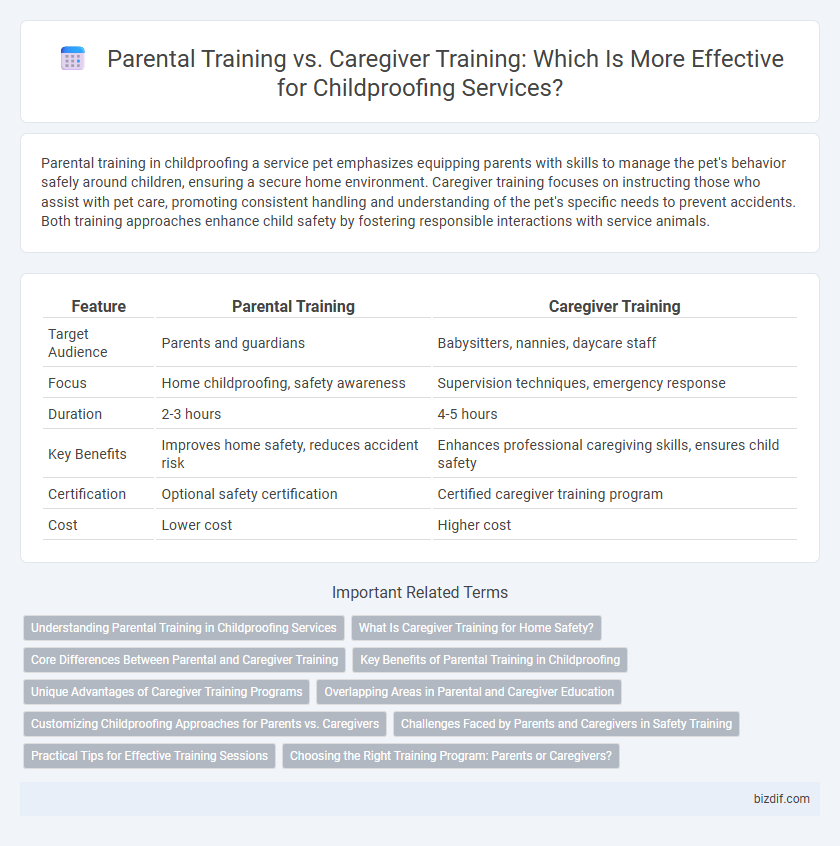Parental training in childproofing a service pet emphasizes equipping parents with skills to manage the pet's behavior safely around children, ensuring a secure home environment. Caregiver training focuses on instructing those who assist with pet care, promoting consistent handling and understanding of the pet's specific needs to prevent accidents. Both training approaches enhance child safety by fostering responsible interactions with service animals.
Table of Comparison
| Feature | Parental Training | Caregiver Training |
|---|---|---|
| Target Audience | Parents and guardians | Babysitters, nannies, daycare staff |
| Focus | Home childproofing, safety awareness | Supervision techniques, emergency response |
| Duration | 2-3 hours | 4-5 hours |
| Key Benefits | Improves home safety, reduces accident risk | Enhances professional caregiving skills, ensures child safety |
| Certification | Optional safety certification | Certified caregiver training program |
| Cost | Lower cost | Higher cost |
Understanding Parental Training in Childproofing Services
Parental training in childproofing services focuses on equipping parents with comprehensive knowledge about potential household hazards and effective safety measures tailored to their home environment. This training emphasizes proactive strategies to prevent accidents, recognizing risk zones, and implementing child-safe practices in daily routines. Understanding parental training helps ensure a safer home by empowering parents with practical skills and confidence to protect their children effectively.
What Is Caregiver Training for Home Safety?
Caregiver training for home safety involves specialized instruction designed to equip non-parental caregivers with the knowledge and skills necessary to create a secure environment for children. This training covers essential topics such as hazard identification, emergency response techniques, and childproofing strategies tailored to various home settings. Ensuring caregivers are properly trained enhances overall child safety and supports consistent supervision standards outside the parental role.
Core Differences Between Parental and Caregiver Training
Parental training focuses on equipping parents with long-term child safety strategies tailored to their family's unique environment, emphasizing emotional bonding and consistent discipline approaches. Caregiver training prioritizes practical, day-to-day safety protocols and emergency response skills, ensuring temporary or professional caretakers can effectively manage childproofing measures in various settings. Both trainings aim to prevent accidents but differ in scope, duration, and emotional engagement with the child.
Key Benefits of Parental Training in Childproofing
Parental training in childproofing empowers parents with tailored safety strategies that address unique home environments and child behaviors, significantly reducing injury risks. This training enhances parents' ability to anticipate hazards and implement preventive measures consistently, fostering a safer living space. Unlike general caregiver training, parental training builds long-term confidence and vigilance in managing everyday safety challenges specific to their children's developmental stages.
Unique Advantages of Caregiver Training Programs
Caregiver training programs offer unique advantages by equipping non-parental adults with specialized skills to identify and eliminate common household hazards, ensuring a safer environment for children. These programs emphasize practical childproofing techniques tailored to diverse caregiving settings, enhancing consistency and vigilance beyond parental supervision. Trained caregivers often develop heightened awareness and proactive prevention strategies, significantly reducing the risk of accidents in childcare environments.
Overlapping Areas in Parental and Caregiver Education
Parental training and caregiver training both emphasize key safety protocols such as childproofing techniques, emergency response skills, and effective communication strategies to ensure a secure environment for children. Both programs cover injury prevention, hazard identification, and proper supervision methods tailored to developmental stages. Shared educational components focus on fostering awareness of potential risks and promoting consistent safety practices across all adults involved in child care.
Customizing Childproofing Approaches for Parents vs. Caregivers
Customizing childproofing approaches requires recognizing the distinct roles and environments parents and caregivers navigate daily. Parental training often emphasizes comprehensive home safety strategies tailored to the family's lifestyle and long-term child development goals. Caregiver training focuses on adaptable safety protocols that accommodate varied settings and flexible routines, ensuring consistent protection regardless of location or caretaker shifts.
Challenges Faced by Parents and Caregivers in Safety Training
Parents often encounter challenges such as balancing safety education with daily responsibilities, limited time for comprehensive training, and difficulty in adapting safety measures to evolving child behaviors. Caregivers may face obstacles including varying levels of prior knowledge, inconsistent communication with parents about safety protocols, and the pressure to maintain vigilance in diverse environments. Both groups require tailored training approaches that address these unique challenges to ensure effective childproofing and injury prevention.
Practical Tips for Effective Training Sessions
Parental training emphasizes tailored strategies that address the unique dynamics and routines of the family, ensuring childproofing measures fit seamlessly into daily life. Caregiver training focuses on standardized safety protocols and emergency response techniques critical for professionals managing multiple children in varied environments. Effective training sessions incorporate hands-on demonstrations, scenario-based learning, and clear communication to reinforce practical skills and build confidence in both parents and caregivers.
Choosing the Right Training Program: Parents or Caregivers?
Choosing the right training program between parental training and caregiver training depends on the specific needs and roles of the individual involved in child supervision. Parental training focuses on equipping parents with strategies to create safe home environments and effectively manage child behavior, while caregiver training emphasizes professional skills for nannies, babysitters, or daycare providers to ensure child safety and emergency readiness. Evaluating the child's primary daytime supervisors and their interaction frequency helps determine whether a parent-centered or caregiver-centered childproofing training program will maximize safety outcomes.
Parental training vs Caregiver training Infographic

 bizdif.com
bizdif.com